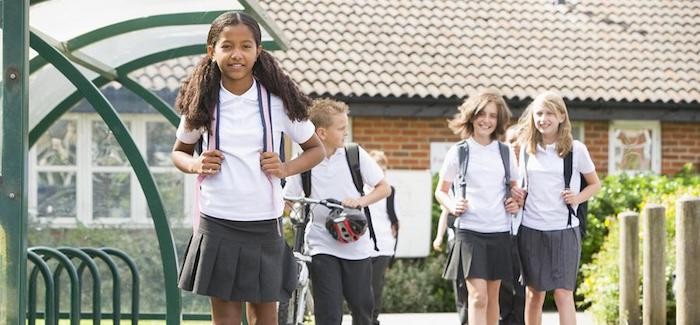With school back in session, now's the time to discuss school transportation options. If you live close enough, walking or bicycling are exciting and healthy ways for children to commute, but you also want to be sure they're taking safe routes to school. You can't be there to guide them every step of the way, and while you want them to enjoy the benefits of going to school on their own (including improved fitness and increased responsibility), you need to know that they have the know-how to make the right decisions. Here's what you can teach your kids to help them stay safe.
Walking Safety
Walking is generally considered a safe option for children to get to school. Because they are smaller and more difficult for drivers to see, however, kids can be at risk of getting injured. Here are some walking safety tips for children from the National Center for Safe Routes to School to ensure a safe trip:
- Walkability. Walk to and from school with them and rate the route's walkability to decide if it's easily navigable for your kids.
- Safe routes. Choose safe routes to school that have sidewalks, minimal traffic, and low vehicle speeds. If the route doesn't have sidewalks, children should walk as far off the road as possible and face oncoming traffic.
- Visibility. To ensure they're seen clearly, children should watch for traffic at all driveways and intersections and always make eye contact with stopped drivers. Additionally, reflective gear should be worn if weather limits visibility.
- Crossing rules. Teach your child to stop at the curb, look, and listen for traffic from all directions to ensure no cars are approaching. Traffic signals and signs should be obeyed at all times. Furthermore, children should only cross a street at a crosswalk or intersection with a walk signal. Teach your child to walk quickly across the road but not to run.
Bicycle Safety
Riding a bicycle is a fun, healthy, and independent way for kids to commute. Unfortunately, more than 300,000 children a year are treated in the emergency department for preventable bike-related injuries, says the Center for Childhood Safety. Here are some bicycle safety tips to help children avoid accidents and ensure safe passage before the morning bell rings:
- Route. Just as with walking, bike with your kids to determine the best bikeable route for them.
- Helmets. All bicyclists, including children, should wear an age-appropriate, fitted bicycle helmet.
- Road hazards. Teach your child how to identify and avoid potholes, storm grates, broken glass, gravel, leaves, or anything else that could make them lose control.
- Always listen. Bike riders need their ears to hear traffic and avoid unsafe situations. No earbuds allowed!
- Crossing rules. Similar to walking, your kids need to know how to deal with busy crossings. Make sure they know to obey traffic signals and signs.
- Visibility. Again, the tips here are the same as for walking. Safe riding and reflective gear are the two keys.
- Turning rules. Children should check behind them and use hand signals before turning left or right.
General Safety Is a Must
You'll want to teach your kids basic safety skills that will help them regardless of the situation. Familiarize them with safe places to go, such as a police station or hospital, along their usual routes. If you have any friends or neighbors on the route, let them know that your kids will be passing by each day. Of course, knowing how to deal with strangers is highly important information. Finally, employing a buddy system with a few of your children's friends is an excellent approach. If you use the majority of these tips, you can minimize your parental worry as your kids get a little cardio on their way to and from school.




